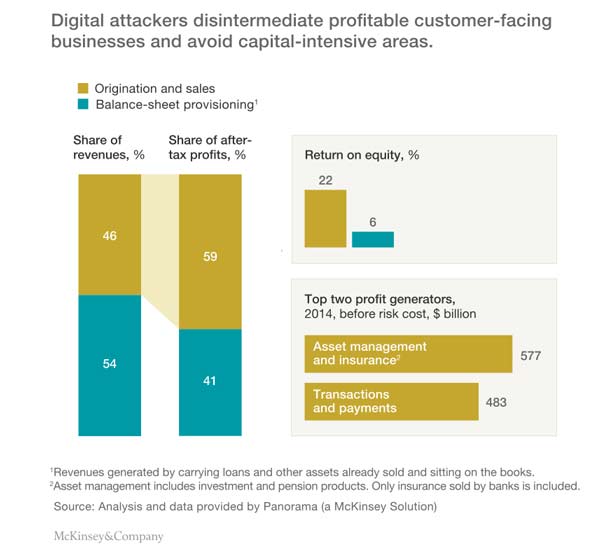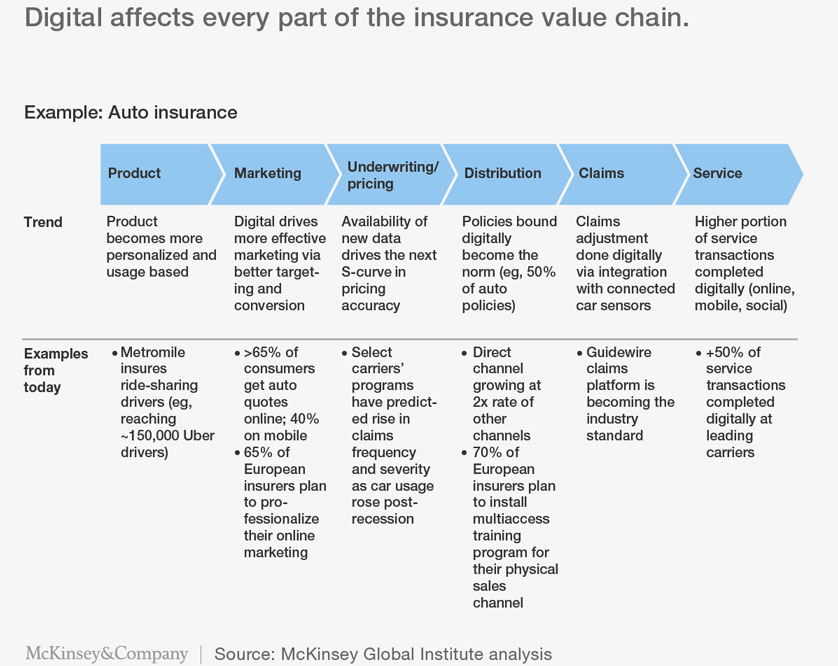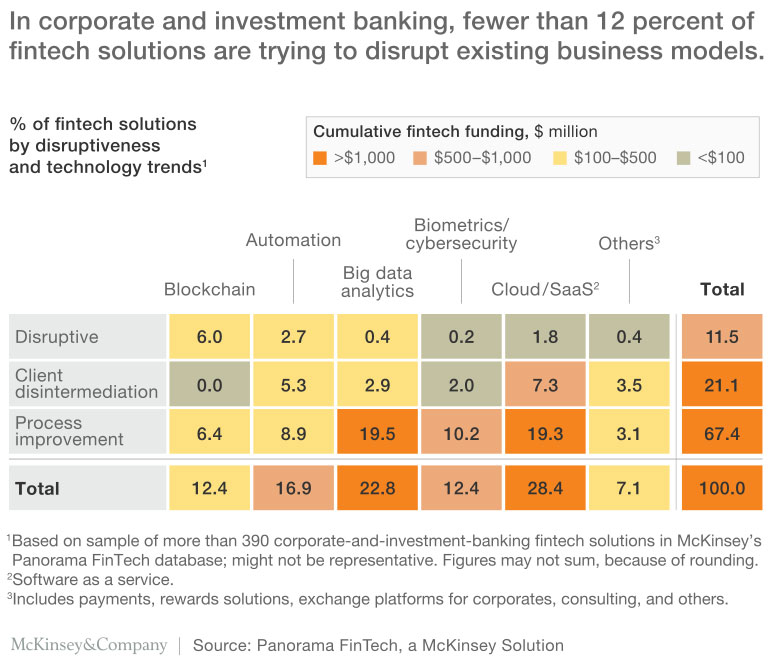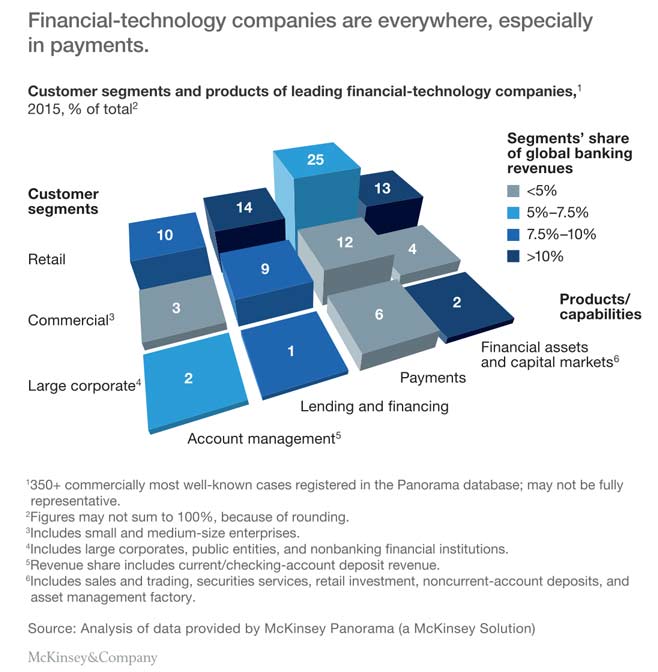The rise of digital innovators in financial services presents a significant threat to the traditional business models of retail banks. Historically, they have generated value by combining different businesses, such as financing, investing, and transactions, which serve their customers’ broad financial needs over the long haul. Banks offer basic services, such as low-cost checking, and so-called sticky customer relationships allow them to earn attractive margins in other areas, including investment management, credit-card fees, or foreign-exchange transactions.
To better understand how attackers could affect the economics of banks, we disaggregated the origination and sales component from the balance-sheet and fulfillment component of all banking products. Our research (exhibit) shows that 59 percent of the banks’ earnings flow from pure fee products, such as advice or payments, as well as the origination, sales, and distribution component of balance-sheet products, like loans or deposits. In these areas, returns on equity (ROE) average an attractive 22 percent. That’s much higher than the 6 percent ROE of the balance-sheet provision and fulfillment component of products (for example, loans), which have high operating costs and high capital requirements. Digital start-ups (fintechs)—as well as big nonbank technology companies in e-retailing, media, and other sectors—could exploit this mismatch in banking’s business model. Technological advances and shifts in consumer behavior offer attackers a chance to weaken the heavy gravitational pull that banks exert on their customers. Many of the challengers hope to disintermediate these relationships, slicing off the higher-ROE segments of banking’s value chain in origination and sales, leaving banks with the basics of asset and liability management. It’s important that most fintech players (whether start-ups or China’s e-messaging and Internet-services provider Tencent) don’t want to be banks and are not asking customers to transfer all their financial business at once. They are instead offering targeted (and more convenient) services. The new digital platforms often allow customers to open accounts effortlessly, for example. In many cases, once they have an account, they can switch among providers with a single click.
Digital start-ups (fintechs)—as well as big nonbank technology companies in e-retailing, media, and other sectors—could exploit this mismatch in banking’s business model. Technological advances and shifts in consumer behavior offer attackers a chance to weaken the heavy gravitational pull that banks exert on their customers. Many of the challengers hope to disintermediate these relationships, slicing off the higher-ROE segments of banking’s value chain in origination and sales, leaving banks with the basics of asset and liability management. It’s important that most fintech players (whether start-ups or China’s e-messaging and Internet-services provider Tencent) don’t want to be banks and are not asking customers to transfer all their financial business at once. They are instead offering targeted (and more convenient) services. The new digital platforms often allow customers to open accounts effortlessly, for example. In many cases, once they have an account, they can switch among providers with a single click.
Platforms such as NerdWallet (in the United States) or India’s BankBazaar.com aggregate the offerings of multiple banks in loans, credit cards, deposits, insurance, and more and receive payment from the banks for generating new business. Wealthfront targets fee-averse millennials who favor automated software over human advisers. Lending Home targets motivated investment-property buyers looking for cost-effective mortgages with accelerated time horizons. Moneysupermarket.com started with a single product springboard—consumer mortgages—and now not only offers a range of financial products but serves as a platform for purchases of telecom and travel services, and even energy.
Across the emerging fintech landscape, the customers most susceptible to cherry-picking are millennials, small businesses, and the underbanked—three segments particularly sensitive to costs and to the enhanced consumer experience that digital delivery and distribution afford. For instance, Alipay, the Chinese payments service (a unit of e-commerce giant Alibaba), makes online finance simpler and more intuitive by turning savings strategies into a game and comparing users’ returns with those of others. It also makes peer-to-peer transfers fun by adding voice messages and emoticons.
From an incumbent’s perspective, emerging fintechs in corporate and investment banking (including asset and cash management) appear to be less disruptive than retail innovators are. A recent McKinsey analysis showed that most of the former, notably those established in the last couple of years, are enablers, serving banks directly and often seeking to improve processes for one or more elements of banking’s value chain.
Many successful attackers in corporate and investment banking, as well as some in retail banking, are embracing “coopetition,” finding ways to become partners in the ecosystems of traditional banks. These fintechs, sidestepping banking basics, rely on established institutions and their balance sheets to fulfill loans or provide the payments backbone to fulfill credit-card or foreign-exchange transactions. With highly automated, scalable, software-based services and no physical-distribution expenses (such as branch networks), these attackers gain a significant cost advantage and therefore often offer more attractive terms than banks’ websites do. They use advanced data analytics to experiment with new credit-scoring approaches and exploit social media to capture shifts in customer behavior.
Attackers must still overcome the advantages of traditional banks and attract their customers. Most fintechs, moreover, remain under the regulatory radar today but will attract attention as they reach meaningful scale. That said, the rewards for digital success are huge. Capturing even a tiny fraction of banking’s more than $1 trillion profit pool could generate massive returns for the owners and investors of these start-ups. Little wonder there are more than 12,000 of them on the prowl today.







